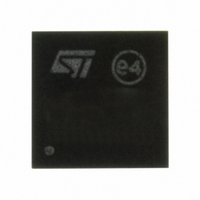PM6600 STMicroelectronics, PM6600 Datasheet - Page 32

PM6600
Manufacturer Part Number
PM6600
Description
IC LED DRIVR WHT BCKLT 24-VFQFPN
Manufacturer
STMicroelectronics
Type
Backlight, White LEDr
Datasheet
1.PM6600TR.pdf
(60 pages)
Specifications of PM6600
Topology
PWM, Step-Up (Boost)
Number Of Outputs
6
Internal Driver
Yes
Type - Primary
Backlight
Type - Secondary
White LED
Frequency
200kHz ~ 1MHz
Voltage - Supply
4.7 V ~ 28 V
Voltage - Output
36V
Mounting Type
Surface Mount
Package / Case
24-VFQFN, 24-VFQFPN
Operating Temperature
-40°C ~ 85°C
Current - Output / Channel
32mA
Internal Switch(s)
Yes
Number Of Segments
60
Operating Supply Voltage
4.7 V to 28 V
Maximum Power Dissipation
2.3 W
Maximum Operating Temperature
+ 85 C
Mounting Style
SMD/SMT
Minimum Operating Temperature
- 40 C
For Use With
497-8414 - BOARD EVAL BASED ON PM6600
Lead Free Status / RoHS Status
Lead free / RoHS Compliant
Efficiency
-
Lead Free Status / Rohs Status
Details
Available stocks
Company
Part Number
Manufacturer
Quantity
Price
Company:
Part Number:
PM6600
Manufacturer:
FUJITSU
Quantity:
2 402
Company:
Part Number:
PM6600TR
Manufacturer:
ST
Quantity:
11 965
Company:
Part Number:
PM6600TR
Manufacturer:
st
Quantity:
5 145
Operation description
7.4.2
32/60
Figure 48. Load transient response measurement set-up
Slope compensation
The constant frequency, peak current-mode topology has the advantage of very easy loop
compensation with output ceramic capacitors (reduced cost and size of the application) and
fast transient response. In addition, the intrinsic peak-current measurement simplifies the
current limit protection, avoiding undesired saturation of the inductor.
On the other side, this topology has a drawback: there is inherent open loop instability when
operating with a duty-ratio greater than 0.5. This phenomenon is known as “sub-harmonic
instability” and can be avoided by adding an external ramp to the one coming from the
sensed current. This compensating technique, based on the additional ramp, is called
“Slope Compensation”. In figure 11, where the switching duty-cycle is higher than 0.5, the
small perturbation ΔIL dies away in subsequent cycles thanks to the slope compensation
and the system reverts to a stable situation.
Figure 49. Main loop and current loop diagram
V
IN
= 6V
+5V
C
IN
COMP
LDO5
BILIM
RILIM
SS
COMP
SGND
V
6.8μH
IN
PM6600
Doc ID 14248 Rev 7
ROW1
ROW2
ROW3
ROW4
ROW5
ROW6
g
PWM
m
LX
0.4V
Up to 10 WLEDs per row
Minimum voltage drop
4.7μF
MLCC
V
BST=30÷36V
selector
ROWx
R
PM6600
L
500Hz
RILIM
SGND
=
50mA
V
BST













